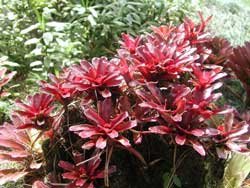Resource Library
Plant of the Week: Bromeliad
The University of Arkansas System Division of Agriculture does not promote, support or recommend plants featured in "Plant of the Week." Please consult your local Extension office for plants suitable for your region.
Plant of the Week
Bromeliad

Though bromeliads have no kinship to cacti, they share one feature: people either love them or hate them. But for those of us who find the association of form and function in plants intriguing, they are hard to resist. So today let’s consider bromeliads.
Bromeliads are monocots in their own family, thus closely related to orchids and aloes. As monocots, their leaves are long and linear and arranged in a whorl with parallel veins.
The 2,400 kinds of bromeliads are native to the Americas and are primarily found in tropical and subtropical zones. Spanish moss (Tillandsia usneoides) occurs in the coastal region of the southern United States as far north as Virginia, but it is a northern outlier. Most species occur in Central America and tropical parts of South America.
They occur in both tropical rainforests and deserts. About half of the species are epiphytes that use trees for support but derive their water and nutrients independently. The others are called lithophytes, plants that use rocks for physical support but obtain their water from the atmosphere. A few, such as pineapples (Ananas comosus) are true terrestrial plants and grow in the soil like a proper plant. All types will anchor themselves in soil if planted in a flower pot.
The whorl of leaves that collects and stores water in the “tank” is the most common adaptation in bromeliads. These tanks support a wide array of plant and animal life that provides the nutrients the bromeliads need for growth. Some species, such as Spanish moss and its kin, absorb moisture directly from humid air, using specially adapted leaf hairs called trichomes.
Flowers of bromeliads are built with a basic number of three but otherwise vary considerably. Most bloom on inflorescences of varying lengths. Species grown as ornamentals have flowers in shades of bright red, orange, blue or yellow. But sometimes the blooms themselves are relatively insignificant, and the showy display comes from the spike bearing the flower or even the leaves surrounding the flower.
Flowering in bromeliads is under the control of ethylene, the only naturally occurring plant growth hormone that exists as a gas. Bromeliads can now be made to bloom at about any season, provided they are large enough to flower, by applying an artificial compound marketed as Florel. This product breaks down to release ethylene gas, with blooms usually appearing in two to three months.
Bromeliads are in many ways the perfect houseplant. They can be dead for six months before you ever notice. What can be better than that?
Because bromeliads, especially the vase-forming species such as Aechmeas, Billbergias and Neoregelias, tend to be top heavy, clay pots and soil-based potting soil add extra stability. The terrestrial kinds such as the Cryptanthus and Dyckias can be grown in any potting soil so long as it is well drained. Most bromeliads are adapted to getting their water from their foliage, not their roots, so keep water in the bromeliad tanks and allow the soil to dry between watering to minimize the chance of root rot.
Growing bromeliads wired to branches is an easy way to grow the plants in a humid greenhouse environment but is not a very practical solution for wintertime conditions in the home. Such a system would work if you want a prickly companion in the shower.
Fertilize with any houseplant fertilizer according to directions, but be sure to apply it to the soil. If you wish to apply it in the tank, reduce the concentration to one-fourth strength.
During the summer, bromeliads should be moved outside to a bright but partially shaded area. If a plant needs division or if part of the center of the plant died when the original plant made offsets, clean up and repot the plant as soon as it is moved outdoors in the spring. During the summer months, bromeliads can be left to their own devices with natural rainfall providing their basic needs. When cool weather arrives, move them inside to a bright window.
By: Gerald Klingaman, retired
Extension Horticulturist - Ornamentals
Extension News - May 23, 2008
The University of Arkansas System Division of Agriculture does not maintain lists of retail outlets where these plants can be purchased. Please check your local nursery or other retail outlets to ask about the availability of these plants for your growing area.